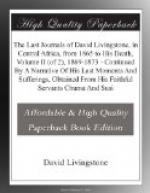It was of no use to try to buy a canoe, for all were our enemies. It was now the rainy season, and I had to move with great caution. The worst our enemies did, after trying to get up a war in vain, was to collect as we went by in force fully armed with their large spears and huge wooden shields, and show us out of their districts. All are kind except those who have been abused by the Arab slaves. While waiting at Luamo a man, whom we sent over to buy food, got into a panic and fled he knew not whither; all concluded that he had been murdered, but some Manyuema whom we had never seen found him, fed him, and brought him home unscathed: I was very glad that no collision had taken place. We returned to Bambarre 19th December, 1869.
20th December, 1869.—While we were away a large horde of Ujijians came to Bambarre, all eager to reach the cheap ivory, of which a rumour had spread far and wide; they numbered 500 guns, and invited Mohamad to go with them, but he preferred waiting for my return from the west. We now resolved to go due north; he to buy ivory, and I to reach another part of the Lualaba and buy a canoe.
Wherever the dense primeval forest has been cleared off by man, gigantic grasses usurp the clearances. None of the sylvan vegetation can stand the annual grass-burnings except a species of Bauhinia, and occasionally a large tree which sends out new wood below the burned places. The parrots build thereon, and the men make a stair up 150 feet by tying climbing plants (called Binayoba) around, at about four feet distance, as steps: near the confluence of the Luamo, men build huts on this same species of tree for safety against the arrows of their enemies.
21st December, 1869.—The strong thick grass of the clearances dries down to the roots at the surface of the soil, and fire does it no harm. Though a few of the great old burly giants brave the fires, none of the climbers do: they disappear, but the plants themselves are brought out of the forests and ranged along the plantations like wire fences to keep wild beasts off; the poles of these vegetable wire hedges often take root, as also those in stages for maize.
22nd, 23rd, and 24th December, 1869.—Mohamad presented a goat to be eaten on our Christmas. I got large copper bracelets made of my copper by Manyuema smiths, for they are considered very valuable, and have driven iron bracelets quite out of fashion.
25th December, 1869.—We start immediately after Christmas: I must try with all my might to finish my exploration before next Christmas.
26th December, 1869.—I get fever severely, and was down all day, but we march, as I have always found that moving is the best remedy for fever: I have, however, no medicine whatever. We passed over the neck of Mount Kinyima, north-west of Moenekuss, through very slippery forest, and encamped on the banks of the Lulwa Rivulet.




